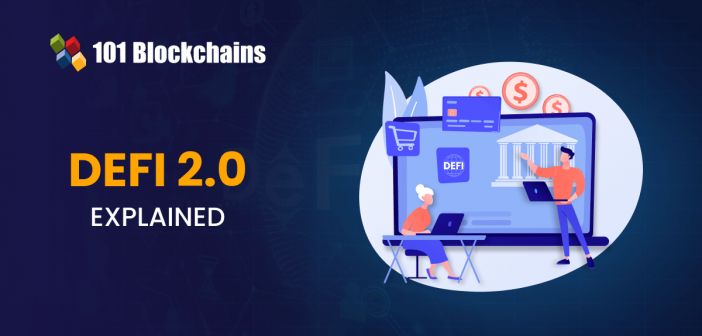DeFi, or decentralized finance, is made up of all the decentralized alternatives to our existing financial world. The difference between DeFi protocols and traditional financial services is that DeFi doesn’t require intermediaries—it uses blockchain technology to get rid of middlemen like banks, brokers, and stock exchanges, who can be expensive.
In the past year, the growth of decentralized finance, or “DeFi,” protocols has been explosive. Total value locked in DeFi protocols is now around $75 billion, and the global market cap for all DeFi tokens is just under $140 billion.
While the DeFi 1.0 protocols offer a wide array of financial services, there is still room for improvement. For example, MakerDAO is a decentralized lending protocol that allows you to put your crypto up as collateral in exchange for less volatile assets like stablecoins. However, there are also derivatives platforms like Synthetics that issue synthetic assets, allowing the creation of crypto indexes, such as the DeFi index.
DEXes are great because they decentralize power away from a single point of control. This means that no single entity can hacked or taken down, which makes DEXes much more secure than their centralized counterparts. DEXes, like Uniswap and Pancakeswap, allow users to create or contribute to liquidity pools in exchange for a portion of the transaction fees. This decentralization of power makes DEXes much more secure than centralized exchanges. Without further ado let’s take a look at 5 things you may not know about DeFi 2.0:
1. DeFi2.0 aims to provide long-term liquidity
2. It will not rely on fiat-back stablecoins
3. It will be more decentralized
4. It will lower user costs
5. DeFi2.0 offers a superior user experience

DeFi 2.0 – A Comprehensive Guide
Decentralized finance (DeFi) is an example of how blockchain-based innovation is changing the way we access traditional financial services. DeFi applications offer a wider range of options than traditional financial services, and they aim to remove intermediaries to make access to financial services more direct. DeFi protocols are constantly evolving, and they are improving on existing models of agreements in the domain of financial services.
DeFi 2.0 is the next stage of decentralized finance. It is a term coined for hyping decentralized finance services. The possibilities for improvements in decentralized finance with DeFi 2.0 solutions are immense. The following discussion offers you an introductory guide on DeFi 2.0 with an overview of background of DeFi developments. You can also discover the setbacks with DeFi 1.0, which established the foundation for DeFi 2.0 solutions, along with an example.
The Decentralized Finance Course will teach you about the scope and purpose of DeFi. You will learn how DeFi can be used to create financial applications that are secure and trustless. The course will also cover the various protocols and platforms that are used to build DeFi applications.
What is the Need of DeFi 2.0?
DAI, that is backed by cryptocurrency collateral. You need to start with a detailed understanding of the timeline leading up to DeFi 2.0 if you want to learn about DeFi 2.0 projects. The pioneer DeFi protocols such as Uniswap, Compound, and MakerDAO established an ideal playground for the thriving DeFi ecosystem. Some of the early players in the decentralized Automated Market Maker or AMM space, such as DeFi applications like Uniswap, enable users to swap tokens without leaving custody. Compound and Aave served as decentralized lending and borrowing platforms with on-chain yield on deposits alongside permissionless access to operating capital. On the other hand, MakerDAO introduced a decentralized stablecoin, DAI, that is backed by cryptocurrency collateral.
The question “What is the need for DeFi 2.0?” can be reasonably asked, with the answer being that it provides advances in comparison to centralized companies. The components that make up every DeFi protocol service offer advantages in transparency and user control. The advancement of these services depend on the constantly changing technology.
Challenges with DeFi 1.0
DeFi 1.0 created a new standard for decentralized financial services, but it had some flaws. The second generation of decentralized finance fixed some of those flaws. Here are the most notable ones.
Liquidity Mining
DeFi protocols that only offer LP tokens as an incentive for liquidity providers generally see those providers withdrawing their resources and rewards on a regular basis. This periodic sale of the native tokens of DeFi protocols leads to a gradual decrease in the overall supply.
Liquidity
DeFi 2.0 is being introduced to resolve the problems of capital inefficiency that are caused by the liquidity requirements of DeFi 1.0 protocols.
Security
One big issue with DeFi 1.0 is that it’s not very secure. This is because software is constantly being upgraded and changed, which can create security vulnerabilities. Also, many DeFi users don’t know how to properly manage risk or validate the security of networks, which can lead to big problems if funds are lost.
Scalability
DeFi 2.0 startups are looking to improve upon the scalability issues that have been plaguing DeFi 1.0 protocols. The hope is that by introducing new solutions, transaction speeds will increase and network fees will decrease.
Oracles
The DeFi model’s effectiveness relies heavily on oracles, which are third-party data sources. The accuracy of the information provided by oracles can have major implications for DeFi users and the protocols themselves.
Centralization
The biggest challenge that DeFi 1.0 protocols face is centralization. Even though these projects are decentralized, they still have to worry about security and scalability, which can only be ensured by compromising on decentralization.
The existing problems with DeFi projects and limitations in the current DeFi model provides a clear overview of what is needed for DeFi 2.0.
DeFi 2.0 aims to provide long-term liquidity
It was clear that DeFi would have to overcome a lack of long-term sustainable liquidity once the sun set on the summer of DeFi in 2020. This is because most DeFi protocols get their liquidity through incentivized liquidity mining.
If you have ever given your tokens to a DeFi platform in return for receiving some of the platform’s native tokens, you have participated in liquidity mining.
As DeFi becomes more successful, new protocols are offering bigger rewards to attract more users. However, this is not sustainable because eventually the platform will run out of rewards. Even if there is an unlimited supply of rewards, eventually so many will be given out that their value will decrease.
The big problem is that you, me and all the other liquidity providers are not obliged to keep our money in the pool. We often cash out when the rewards run out, which is usually when the whales cash out too. That drains all the liquidity from the protocol and the value of the native token plummets.
A couple of platforms have developed some innovative and interesting ways to solve this issue. They have been widely praised as the new wave of DeFi 2.0 protocols and one of these new potential DeFi 2.0 protocols is GTON Capital. GTON Capital owns 99.5 percent of its liquidity as a concept called “protocol owned liquidity” or POL. $GTON is a decentralized reserve currency that GTON uses to make it more and more difficult for the crypto whales to drop their positions all at once and crash the tokens value.
The GTON token is backed by a treasury that is owned and controlled by the GTON Capital DAO. This treasury has a balance of more than 4 million dollars, which allows for the implementation of an innovative approach for liquidity management called Pathway. Pathway is an algorithm that enables market making activities using treasury funds. This algorithm assesses the project’s fundamental metrics and determines the optimal MM scope.
It won’t rely on fiat-back stablecoins
DeFi 1.0 protocols rely heavily on stablecoins. However, this is not consistent with what DeFi is all about. DeFi is supposed to move us away from inflationary centralized currencies, like the US dollar. For now, fiat-backed stablecoins are necessary for DeFi 1.0 protocols.
In order to avoid the problem mentioned, DeFi 2.0 has been implementing protocols that use a decentralized reserve currency. This currency functions similarly to a stablecoin, but is not pegged to any particular asset. Instead, it is a free-floating reserve currency that is backed by a variety of assets.
DeFi 2.0 will be more decentralized
Critics of DeFi say that it is not truly decentralized because many of the protocols are run by DAOs. Some protocols have moved to a DAO operating structure to address this concern.
While a lot of popular DeFi platforms function as DAOs, there are a few things to consider before opting for a DAO structure. The primary advantage of a DAO is that it offers a more democratic way to organize and operate while addressing the centralization concerns of DeFi users. However, there are a few things to keep in mind before opting for a DAO structure. For instance, because anyone can propose changes to a DAO, it can be difficult to reach a consensus. In addition, DAOs are still a relatively new concept, so there is a lack of precedent to guide decision-making.
This shift to DeFi 2.0 protocols, which are mostly DAOs, will bring about a lowering of user costs and offer a better user experience overall.
DeFi 2.0 will lower user costs and offer a superior user experience
Making DeFi more affordable and user-friendly would help it become more mainstream.
We have grouped the DeFi protocols together because we believe that they need to adopt a more sustainable way to source their liquidity. As we covered in the first part of this article, this is important for two reasons: lower costs and a better user experience.
Ethereum 2.0 needs to go live in order to improve the speed and scalability of DeFi protocols. Currently, most DeFi protocols run on Ethereum but suffer from low transactions due to high gas fees. This makes it difficult to scale the protocols. Ethereum 2.0 would reduce gas fees and make it easier to scale DeFi protocols, making them more accessible to more people.
priced out: too expensive for someone to afford Incrementally: gradually or slowly There are a lot of new DeFi users who are first-time crypto users and are priced out of the market. Some people avoid DeFi because they don’t understand how to use it. MetaMask is a web 3.0 wallet that has made DeFi more accessible, but even people who are familiar with crypto can make mistakes, like sending a token to the wrong network. These products and services are improving all the time, making DeFi easier to use every day. For example, MetaMask is trialing a new wallet that is designed for institutional investors. This could bring more institutional investment to DeFi.
This means that the combination of sustainable funding from DeFi and the improvements expected from Ethereum 2.0 will provide a better and cheaper user experience during the DeFi 2.0 era.

Leave a Reply